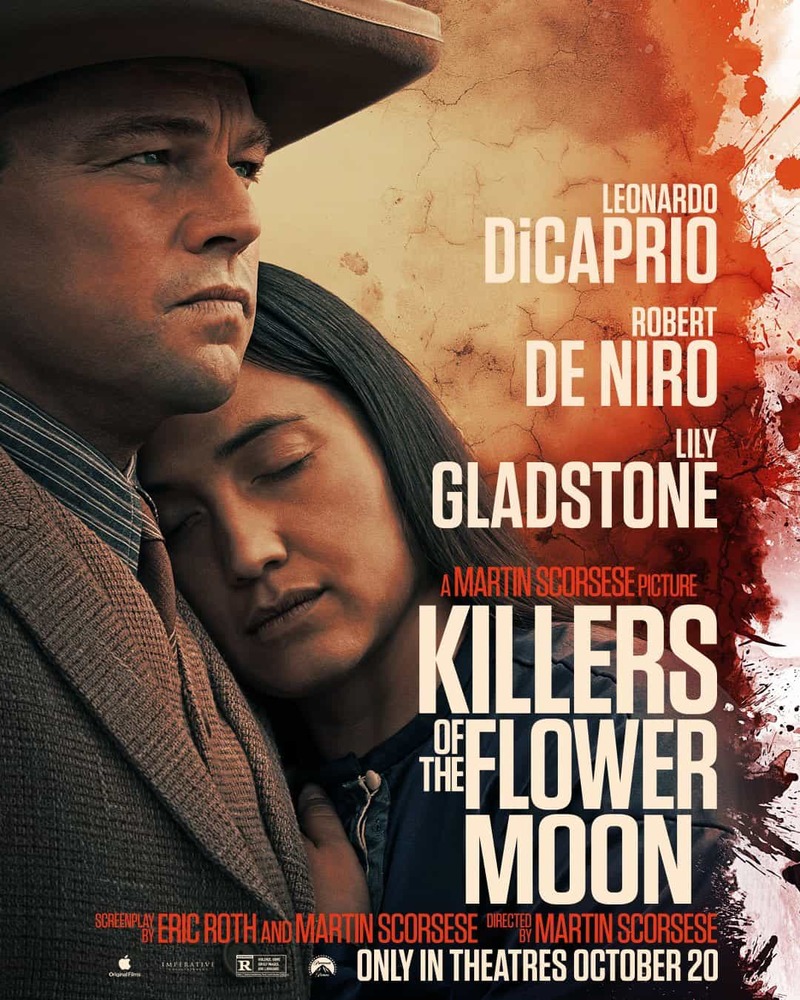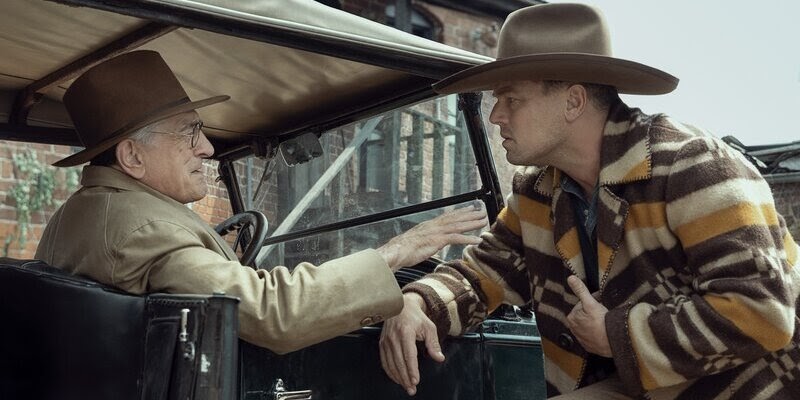
A cattle rancher instigates a murderous campaign to steal the oil rich
land of 1920s Oklahoma's Osage people.
Review by
Eric Hillis
Directed by: Martin Scorsese
Starring: Leonardo DiCaprio, Robert De Niro, Lily Gladstone,
Jesse Plemons, Scott Shepherd

Perhaps the most shocking moment in mainstream American cinema comes in
Phil Karlson's 1955 thriller The Phenix City Story. In an attempt to warn off the film's hero, a bunch of mobsters abduct
the young daughter of his black neighbours. Later a car drives by and
the child's dead body is dumped on her family's lawn. Aside from the
obvious horror of the murder of a child, what's most disturbing about
this scene is how in the eyes of the mobsters a black child's murder is
considered lowly enough to serve merely as a warning; it might as well
be a dog they've taken and killed.
There are several moments in Martin Scorsese's true crime drama
Killers of the Flower Moon that echo this scene, though
none have the same visceral power. Here we see white men kill indigenous
Americans in the same casual manner. Unlike his gangster movies, where
bad men generally only kill other bad men, Scorsese doesn't make
set-pieces out of these killings. There's a swiftness to their
brutality, and they're often carried out like errands by men eager to
get a dirty deed out of the way before they go drinking or gambling, who
react to being ordered to kill like a teenage boy whose mother has asked
to bring the bins in. At one point we see an unconscious drunk
indigenous man's body lie on the floor while two white men openly
discuss their plan to kill him for an insurance payout.

Karlson made several movies about the evil that infects American towns
once they become prosperous, and Scorsese's film plays like one of those
pictures on an epic scale. The newly minted town here is Fairfax,
Oklahoma, which in the early 20th century made its native Osage people
some of the richest folk in the world when they ironically struck oil on
what the white man assumed was useless land. The Osage's newfound wealth
attracted opportunists and vultures, but their biggest enemy was hidden
within their community. William "King" Hale was a local cattle rancher
and self-professed friend to the Osage. He was also responsible for
killing them off in numbers that practically equated to genocide, so
determined was he to control their riches.
Hale is played here by Robert De Niro, an Italian/Irish-American
actor who began his career looking like a handsome Italian peasant and
appears to be ending it resembling a mutton-headed Irish farmer. Legend
has it he stopped being good at some point in the mid-90s, but his
recent revival with Scorsese suggests it might have just been the
pictures that got small. De Niro is magnetic here, simultaneously
charming and terrifying, like every young boy's grandfather. We might
ask why the Osage would trust him – isn't he clearly a wrong 'un? But we
have to remind ourselves that the Osage don't realise he's Robert De
Niro. Scorsese cleverly uses De Niro's screen history against Hale. When
we see him receiving a shave we immediately think of his Al Capone in
The Untouchables, but the Osage haven't seen De Palma's film. To them he's their
benevolent white friend.
When Hale's nephew, Ernest Burkhart (Leonardo DiCaprio), arrives
in Fairfax looking to make a quick buck and a quick Buick, the
Iago-esque Hale begins pulling strings. Ernest is assigned as driver to
a young Osage woman, Molly (Lily Galdstone), in the hopes that he
can charm his way into her hand in marriage. Meanwhile Ernest is
performing a series of petty crimes with some no-good friends, which
doesn't sit well with Hale, who prefers to play the long game of
eventually getting power over Molly's estate.

The romance between Ernest and Molly borrows liberally from Hitchcock's
Suspicion. Like Joan Fontaine (or Lorraine Bracco in Scorsese's own
Goodfellas), Molly suspects the man she loves is up to no good (she constantly
refers to Ernest as a "coyote"), but marries him regardless. Soon after
their wedding, Molly succumbs to debilitating diabetes. Her wealth
allows her to become one of only five people in the world to receive
insulin at the time, which her dutiful husband insists on administering
himself. Like the milk Cary Grant brings to Fontaine in Hitchcock's
film, its poisonous nature is left ambiguous.
We've become accustomed to DiCaprio recently favouring the sort of
roles that require him to act as though he's nursing a permanent ulcer,
but when Molly speaks in no uncertain terms about how attracted she is
to the roguish Ernest, we're reminded that DiCaprio is indeed a matinee
idol. The character of Ernest might be seen as a comment on the idea
that movie stars can be cursed by their looks. Like Rob Lowe in Bob
Swaim's Masquerade, DiCaprio's Ernest is chosen to perform a despicable task because of
his sex appeal, but the tragic irony is that Molly would have fallen for
Ernest without Hale's machinations, and the pair may have lived happily
ever after.

At close to 3.5 hours, Killers of the Flower Moon never
fails to justify its running time. It moves rapidly from one devious
scheme to another, all the while propelled by a Ry Cooder-esque score by
the late Robbie Robertson that ticks away like a malevolent
metronome. Is it disturbing? Yes. This is a story of evil men and how
their inability to view people who don't look like them as equals allows
them to gun them down like rabbits. But it's also a Scorsese crime
drama, which means it's highly entertaining.
This is something Scorsese seems to wrestle with throughout the film.
As mentioned, the killings are presented in the most blunt fashion
possible as Scorsese strives to avoid any sensationalism. In a coda that
takes us inside a theatre where a 1940s radio programme about the Osage
murders is being broadcast live, Scorsese literally gives himself the
last word as he reads Molly Burkart's obituary, the director struggling
to suppress his emotions. What's also shocking about the aforementioned
scene in The Phenix City Story isn't just that the movie's
villains viewed a little black girl's life as having less value than
that of a white child, but that the filmmakers knew the audience shared
the same sentiment. Killing a white child would have marked the point of
no return, but killing a black child left room for escalation in the
minds of 1950s American cinemagoers. There's no such room for escalation
in Killers of the Flower Moon. The deaths of the Osage don't serve as a warning to any heroic white
figures, but to us all at a time when the western world seems intent on
judging the value of victims of conflict by the colour of their
skin.


